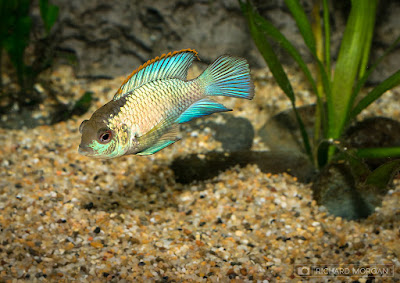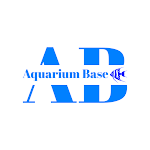Blue acara - Andinoacara pulcher is very popular in the fishkeeping hobby on account of its beautiful colours, relatively peaceful temperament...
Blue acara, also know as Cychlasoma pulchrum, Aequidens pulcher and its scientific name Andinoacara pulcher, is very popular in the fishkeeping hobby on account of its beautiful colours, relatively peaceful temperament, and its willingness to reproduce so readily in the home aquarium.
BLUE ACARA - ANDINOACARA DESCRIPTION
Blue acara is native to Colombia, Trinidad and Tobago, Bolivarian Republic of Venezuela (Venezuela). It has been introduced into several countries outside of northern South America, including the United States, Australia, and Indonesia. It is found living in shallow streams with variable conditions (pools, riffles, undercut banks, high flow), also in swamps and floodplains, where it is more abundant in the rainy season.
Andinoacara pulcher normally grow to 12- 15 cm in length, with a life span of 8-10 years. The body is compact and stocky, while the fins are long and flowing, with a rounder head than on similar cichlids. A distinctive black line is present going from the eye down the cheek; this one line is not found on other similar cichlids.
This fish exhibits slight geographical differences in colour. The colouration varies regionally between the various populations, from a pale off-white blue to a bluish-green and even a dark/deep blue. Some reports have sighted variants with red or even orange dorsal fins.
Mature males will be larger and develop slightly pointed dorsal and anal fins, where as females will be smaller and generally have a more rounded appearance than males.
The fish is often confused with another South American cichlid from the same genus, the Green Terror, Aequidens rivulatus. The latter species is a lot more aggressive than the Blue Acara, so it’s best to research before you buy.
BLUE ACARA - ANDINOACARA CARE
Blue acara needs a tank of 30 gallons for a pair with a water temperature of 24 - 28 °C, pH level of 6.5-7.8 and general hardness of 100-250 ppm. The tank should be set up with a soft, sandy substrate and tangles of driftwood. Hardy plants can be included, floating plants are also a good addition to help diffuse the lighting. Filtration should be efficient, good water quality should be provided at all times.
Keep no more than 4 females per male, and a 20% water change weekly. The more densely packed your tank is the more water that should be changed weekly. Use a gravel cleaner during water changes to ensure all the decomposing organic matter is removed. Although they are sometimes susceptible to Ich and saltwater diseases, they aren’t particularly prone to illness if proper care is taken.
have a relatively peaceful temperament, at least when not protecting young. They have the potential to bully smaller fish and are therefore normally housed with fish of their own size or larger. It is best kept with other reasonably peaceful American cichlids such as: Festivums (Mesanauta festivus), Convicts (Amatitlania nigrofasciata), Firemouths (Thorichthys meeki), Severums (Heros severus) and Geophagus sp.
In the wild this fish is primarily carnivorous, eating small fish, crustaceans and insects. In the aquarium however it will eagerly take pellets and most commercially available fish foods. It recommend high protein based foods, that contain a larger amount of fish meal such as bloodworm, brine shrimp, chopped mussel or prawn and earthworms. To get the best coloration from your fish, offer them live red earthworms from time to time. This fish will also benefit from frozen foods.
Two smaller feedings, once in the morning and once at night, are preferred over one large feeding once a day. This can cause the water quality in your tank to drop quicker than it needs to. Having one day a week you don’t feed them can be beneficial too.
BLUE ACARA - ANDINOACARA SPAWNING
is one of the easiest substrate spawning cichlids to breed. It has sedentary habits. Ideally the water will be slightly soft and acidic, with the temperature set at the higher end of the preferred range. The males are more colorful and larger than the females, and turn a more vibrant blue in the reproductive season.
To obtain a pair, simply buy 5-6 juveniles and allow them to grow up. Once a pair forms naturally, it is wise to remove the others, unless you have a large aquarium. If you provide lots of potential spawning sites like flat rocks, stones and broad leaved plants, spawning will occur with relative ease.
Both male and female clean a rock which will be the spawning area. Eggs are laid on the rock by the female and fertilized by the male. Both male and female guard the eggs, which hatch in 2 to 5 days, and continue to look after the fry for some weeks. In cases of danger, the male protects its young by placing them inside its mouth.
Once the young are free swimming (usually around 7 days post hatch), they can be offered infusoria, baby brineshrimp (Artemia nauplii) and powdered fry foods, moving on to larger foodstuffs as they grow. It is not uncommon for well-conditioned adults to spawn again after only a couple of weeks.
BUY BLUE ACARA - ANDINOACARA AND RELATED PRODUCTS














COMMENTS